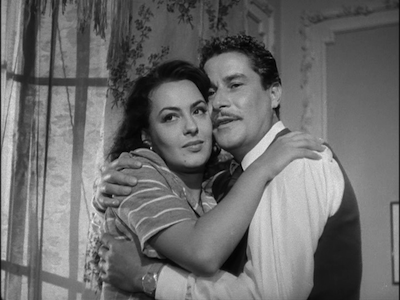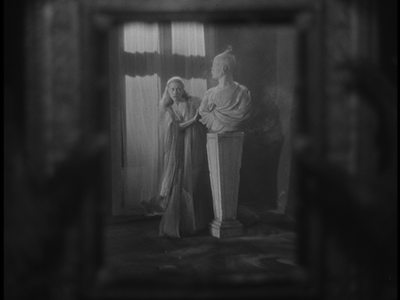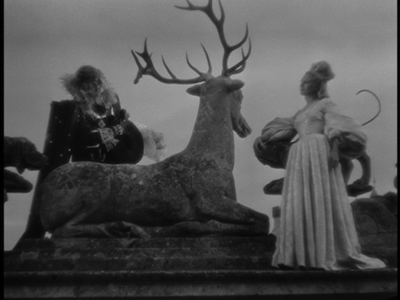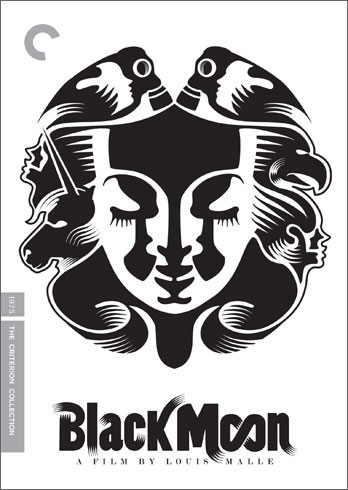
When Criterion was releasing their most recent Eclipse set,
Raffaelo Matarazzo's Runaway Melodramas, a fellow Portland-based film critic,
Shawn Levy, was wondering aloud about this relatively obscure filmmaker. Shawn tweeted, "Matarazzo gets one sentence each in Shipman's 'Story of Cinema' and Bondanella's 'Italian Cinema,' and four paragraphs in Liehm's 'Passion and Defiance.'" The implication is that, in all of cinema history, Matarazzo is little more than a footnote. Neither this assessment nor Shawn's posting is a dismissal, but a curious inquiry. Who was this mid-century Italian director that we were all about to be (re)introduced to?
According to the liner notes that accompany the set, Matarazzo was a journeyman filmmaker with a long line of mid-range studio pictures under his belt but little by way of mainstream success when he shifted gears in the late 1940s. Following the Neorealist remodel, Matarazzo dismantled and rebuilt his approach, marrying old-school sensibilities with new-school technique. Having helmed a lot of literary adaptations prior, the director decided to take the stuffy strictures of traditional melodrama and shoot them in the more naturalistic manner that De Sica and Rossellini were popularizing in post-War Italy.

How this all turned out is...well, it's interesting. Some of the tell-tale signs of the Neorealist style are immediately apparent, but so are the tropes and traditions of the dramatic format, including all the narrative coincidences and overwrought emotions that practically made "melodrama" a dirty word in the last couple of decades. Matarazzo's films work both sides of the class divide, and he shoots the upper classes and the lower in the same light. Sure, the rich stepmother in
Tormento may live in a large apartment, but in keeping with the modern aesthetic, the director doesn't dress it up further, using instead the space as it is. He works out in the open, which allows him to circle and photograph life from its varying angles. He takes no real allegiance with one side or another, at least not as determined by social standing. His characters are more clearly defined by actions: good is good, and bad is bad.

The watershed movie for Matarazzo was 1949's
Chains (Catene) (94 mins.) , which teamed him with the Titanus studios and actors Yvonne Sanson and Amedeo Nazzari. Sanson in particular was a revelation, a new find whose sensuality and beauty is immediately striking, and yet who fits easily into the roles of mother and devoted wife. In
Chains, she plays Rosa, and Nazzari is her husband Guglielmo, a mechanic who owns his own shop and is looking to expand. They have two children, a young daughter named Angelina (Rosalia Randazzo) and a growing boy eager to be a man, Tonino (Gianfranco Magalotti). They are the typical working class nuclear family, the core unit of the decade to come.
Things change for the worse for them overnight, however, and the clan finds themselves stuck in a plot straight out of a pulp magazine. A car thief having engine trouble parks in Guglielmo's garage. His partner Emilio (Aldo Nicodemi) turns out to be Rosa's former fiancé, who went to war and as far as she knew, never came back. Seeing each other again awakens old feelings, and Emilio sticks around, insinuating himself into Guglielmo's business in hopes of getting Rosa back in his arms.

Matarazzo reveals himself master of the slow burn in
Chains. Emotions simmer before they boil, and though his pacing is perhaps too languid at times, it does have its payoffs. A particularly powerful scene comes midway when Tonino sees hands clasped under a table and realizes that maybe his mother is up to no good. Matarazzo doesn't crank the emotion here, he just lets it settle. The boy watches, the reality of the scenario sinks in, the feeling takes root. The director uses "live" music to underscore this scene, as he does throughout the film. Neapolitan ballads are full of stories of lost love and pain, and Matarazzo isn't afraid to choose a number with obvious parallels to his story. Later in
Chains, after Guglielmo has found himself in legal hot water, a Christmas Eve crooner hits the fugitive father right in the heart with his overwrought lyrics.

Music serves a similar role in Matarazzo's follow-up film,
Tormento (1950; 98 minutes). In this feature, Roberto Murolo plays a singer who re-enters the heroine's life midway through the story, and his songs unknowingly detail every heartbreak and sacrifice she has to make in the film. Yvonne Sanson stars again, this time as Anna, a loving daughter and mother who has been victimized for years by her cartoonishly evil stepmother (Tina Lattanzi). After her husband-to-be (Nazzari again) is falsely convicted of a crime, Anna must take care of their child on her own. On his deathbed, her father (Annibale Betrone) makes his wife swear to take care of his granddaughter, but the mean old witch will only do so if Anna locks herself away in a home for wayward women. Like her husband, Anna is innocent of any sin, much less a crime--she doesn't even cheat with the musician, and loses her job because she won't bend over for her boss (Nicodemi)--but the young girl's failing health takes precedence over her reputation.
A theme of compromised piety and female sacrifice emerges in Matarazzo's work in both of these films. In
Chains, Sanson's character can save her husband by accepting charges of adultery; in
Tormento, she acquiesces to the stepmother's lies to give her daughter a better life. Matarazzo's technique, it seems, is to bring his heroine as low as he can, letting the audience suffer with her and testing our expectations, seeing how far he can strain our belief that things will turn out all right in the end. This, of course, only increases the relief when they do. It's a move that works better in the earlier film; the back half of
Chains is full of predictable, yet tantalizing, plot machinations, whereas
Tormento is more plodding, full of hand wringing and cruel proclamations. The coincidences pile on one after the other, including a well-timed heart attack that strikes like lightning. It's the kind of storytelling that can be delicious fun when given a more feverish tone, but
Tormento is too restrained. When the dirty deeds are slowed down this much, it's hard not to note how overdone it all is.
Tormento borders on self-parody.

Things move from the city to the country in 1952's
Nobody's Children (
I figli di nessuno) (96 mins.), and it's best to know going in that it and the last film in
Runaway Melodramas, 1955's
The White Angel (100 mins.), form a two-part epic of misery and heartbreak. This helps some of the storytelling leaps in
Nobody's Children make sense--though others really are just jumpy moves from one plot point to the next without much in between. Of the quartet presented in this box,
Nobody's Children has the choppiest third act.

Nobody's Children is set in a quarry owned by the Canali family. Countess Elisabeth (Francoise Rosay) has been running the family business since becoming a widow, though her son Count Guido (Nazzari) will take over one day. Not soon enough for him. He wants to change the poor conditions and replace the outmoded equipment, but the foreman Anselmo (Folco Lulli) is in the way. To keep his hold on everything, Anselmo interferes with more than just business life: he rats out Guido for having a love affair with Luisa (Sanson), the daughter of the quarry's security guard. Behind-the-scenes scheming to separate them works, and on the Countess' orders, Anselmo even kidnaps the baby that Guido knows nothing about--only for the house Luisa was hiding in to burn down, too, and compel Luisa to think the child died. Oh, and did I also mention that she has already faked her own suicide? Following the child's death, she becomes a nun, one cruelly assigned to serve in the town where her life went so wrong.

This is the most fevered set-up so far, and Nazzari and Sanson slip comfortably into their expected roles: he is arch and unyielding, she is constantly at her wit's end. The quarry backdrop makes the human foibles on display seem all the more primitive, though some of the interior sets look fake compared to the craggy exteriors. Folco Lulli makes for a particularly slimy villain, giving Matarazzo his most believable threat so far. Anselmo's greed even transcends class barriers: he inadvertently provides the link between the trod-upon miners and the benevolent boss, because as the middle man, Anselmo does the trodding. It's bizarre social commentary. We could all get together, regardless of position, but the rats among us keep us separated.
The second half of the film focuses on Bruno (Enrico Olivieri), the kidnapped child. Guido's mother has been paying for his boarding school tuition. As Bruno gets older, he begins to wonder about his past; the headmaster tells him he's an orphan, but the other kids tease him for being a bastard, and he wants to know who his secret benefactor is. He runs away to find Anselmo after discovering the crook's address and starts working in the quarry, right under his real family's nose. And since this is Matarazzo, his journey to his hometown is soundtracked by a troubadour with a guitar!

The script for
Nobody's Children grows pretty convoluted, though the protracted, tense climax more than makes up for it. It's true cinema cliché: Bruno rushes to stop some dynamite from detonating while Anselmo and Guido wrestle in the dirt down below. It adds a ticking-clock element to Matarazzo's work that we haven't seen before, while also setting him up for the weepy sickbed scenes he loves so much. The concluding scenes are also a bit of a curveball, as they don't deliver what we might usually expect from this kind of picture. Then again, there is a sequel...
Note: It's pretty much impossible to write about the next film without giving away at least something about what happens in Nobody's Children. If you are the type that gets queasy and/or senstivie about spoilers, you might want to go pour yourself some milk and come back later.
The White Angel picks up the story by repeating the final scene of
Nobody's Children. Distraught over Bruno's tragic fate, Luisa has transferred to another convent, leaving no forwarding address, while Guido is angry about the role his wife (Enrica Dyrell) played in the deception. Wanting to erase all reminders of the past, Guido dissolves his marriage and is about to get rid of the quarry, too, when another tragic twist forces him to get himself back together. While away on business, he spots a woman in the train across from his and runs to meet her. She is a showgirl named Lina, and she is a dead ringer for Luisa. (She should be, she's also played by Yvonne Sanson.) Guido strikes up a tenuous relationship with her, and narrowly avoids being conned by the girl and her rotten boyfriend (Philippe Hersent).
The plot takes a surprising turn when Lina is sent to prison for holding on to her boyfriend's counterfeit money. In jail, she has a pretty bad time of it, especially after she runs afoul of the sexy head prisoner (Flora Lillo). Matarazzo isn't above a little behind-bars lady fighting. Lina begins to see the light after her beatdown, and it's revealed she is pregnant with Guido's baby. Adding to the weirdness, the doctor who comes to take care of her works in the same church as Luisa and is taken aback by the resemblance. Knowing this is why Guido liked her, Lina asks to see her twin so that she can tell the nun her story.

The White Angel is probably the best movie in the box, and it provides the set with the appropriate closure. Not only does it circle back to the beginning by embracing the same pulpy plot style as
Chains, but it provides the most believable transformation and sets things right in Guido and Luisa's world. Throughout the
Runaway Melodramas set, Yvonne Sanson's characters have been striving for atonement, often seeking it through religious conversion and an affirmation of family. Though
The White Angel would make no sense if its lovers came back together in the finale--Luisa is a nun, after all--where they end up is perfectly logical and also extremely satisfying. One could even interpret the situation as the man finally having to accept responsibility for his sins and do the right thing. The women no longer need to carry the burden unfairly.
It probably doesn't hurt that Matarazzo goes for broke in this last entry, either. He has shed most of the Neorealist clothes he had put on previously, and
The White Angel is at his most "Hollywood." Brooding lovers, flamboyant criminals, heavy consequences, and a tone of swelling, heaving orchestration to carry it along. Speedboats crash in brutal storms, fires get started during daring prison escapes, and despite all the talk of God and Catholicism, yet another infant is born out of wedlock. (For four movies that lack any onscreen sex, there sure are a lot of babies!) It's still not as great as, say, a Douglas Sirk or Vincent Minnelli movie, but few are, really.
Raffaelo Matarazzo's Runaway Melodramas ends better than it starts, and that in itself is its own kind of atonement.

Raffaello Matarazzo's Runaway Melodramas, the 27th entry in Criterion's long-running Eclipse series, gives us four obscure, little-seen films from a six-year span in one Italian director's career. Though the movies here sometimes suffer from convenient plotting and other shaky storytelling choices, the presence of two strong lead actors, and in particular Yvonne Sanson, keeps the drama riding high. In fact, keeping a core team throughout means we get to watch the filmmakers build something, honing their craft until they get it exactly right. The set particularly gets good the more scandalous the scripting, and fans of overwrought love stories will dig seeing these well-made
Runaway Melodramas hit the familiar genre buttons.

For a complete rundown on the special features, read the full review at DVDTalk.

































